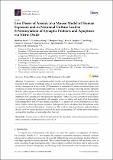Low Doses of Arsenic in a Mouse Model of Human Exposure and in Neuronal Culture Lead to S-Nitrosylation of Synaptic Proteins and Apoptosis via Nitric Oxide
Author(s)
Amal, Haitham; Gong, Guanyu; Yang, Hongmei; Joughin, Brian A.; Wang, Xin; Knutson, Charles G. F.; Kartawy, Maryam; Khaliulin, Igor; Wishnok, John S.; Tannenbaum, Steven R; ... Show more Show less
Downloadijms-21-03948-v2.pdf (4.794Mb)
Publisher with Creative Commons License
Publisher with Creative Commons License
Creative Commons Attribution
Terms of use
Metadata
Show full item recordAbstract
Background: Accumulating public health and epidemiological literature support the hypothesis that arsenic in drinking water or food affects the brain adversely. Methods: Experiments on the consequences of nitric oxide (NO) formation in neuronal cell culture and mouse brain were conducted to probe the mechanistic pathways of nitrosative damage following arsenic exposure. Results: After exposure of mouse embryonic neuronal cells to low doses of sodium arsenite (SA), we found that Ca[superscript 2+] was released leading to the formation of large amounts of NO and apoptosis. Inhibition of NO synthase prevented neuronal apoptosis. Further, SA led to concerted S-nitrosylation of proteins significantly associated with synaptic vesicle recycling and acetyl-CoA homeostasis. Our findings show that low-dose chronic exposure (0.1-1 ppm) to SA in the drinking water of mice led to S-nitrosylation of proteomic cysteines. Subsequent removal of arsenic from the drinking water reversed the biochemical alterations. Conclusions: This work develops a mechanistic understanding of the role of NO in arsenic-mediated toxicity in the brain, incorporating Ca[superscript 2+] release and S-nitrosylation as important modifiers of neuronal protein function.
Date issued
2020-05Department
Massachusetts Institute of Technology. Department of Biological Engineering; Massachusetts Institute of Technology. Department of Chemistry; Koch Institute for Integrative Cancer Research at MITJournal
International Journal of Molecular Sciences
Publisher
Multidisciplinary Digital Publishing Institute
Citation
Amal, Haitham et al. "Low Doses of Arsenic in a Mouse Model of Human Exposure and in Neuronal Culture Lead to S-Nitrosylation of Synaptic Proteins and Apoptosis via Nitric Oxide." International Journal of Molecular Sciences 21, 11 (May 2020): 3948 ©2020 Author(s)
Version: Final published version
ISSN
1422-0067
1661-6596